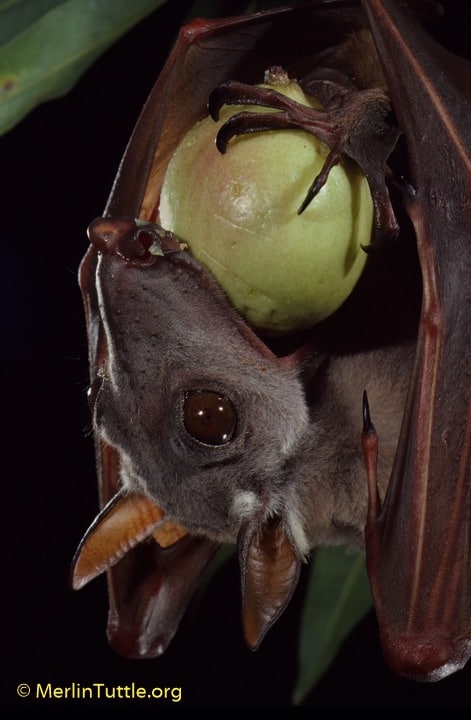Tracking the Impacts of WNS at Wisconsin’s Stonefield Historic Site
“Just like the old days, eh Heather?” Kent softly clicks his tally counter as he sits in his folding chair on the other side of
Virologists are still doggedly pursuing the search for an Ebola reservoir in bats, as reported in the story titled Hunting for Ebola among the Bats of the Congo in the June 1, 2017 issue of Science (Kupferschmudt 2017), apparently attempting to ignore mounting evidence pointing elsewhere. The record of unsubstantiated speculation, attributing Ebola to bats is long and becoming an embarrassment to good science.
By 2014, researchers had discovered that 10% of gorillas in Central Africa have antibodies to Ebola, demonstrating that exposure or infection is not uniformly lethal as previously reported (Reed et al. 2014). Because great apes were said to be highly susceptible, virologists had insisted they couldn’t serve as reservoirs. Instead they pointed to bats.
Nancy Sullivan, a viral immunologist with the Vaccine Research Center at the National Institutes of Health (Pedris 2017), now notes that “there is little evidentiary data to document widespread death of apes from Ebola.” The discovery that great apes can survive Ebola infection is a potential breakthrough in the hunt for a reservoir.
Frequent speculation has suggested that bats were stressed by deforestation that also brought them into closer contact with humans. This hypothesis appears far more likely to explain how great apes, who now appear to have harbored Ebola all along, began spreading it to humans. Gorilla and chimpanzee territories have been forced into conflict-inducing proximity while they are also more intensely hunted. Stress seems to be focused more on them.
It is possible that a reservoir could have been found much sooner, had scientists not been so determined to prove bats guilty. Indeed, the first human Ebola outbreaks were traced to eating great apes (Leroy et al. 2004). Those who blamed bats ignored the fact that huge numbers have been eaten without a single documented case of disease transmission.
The real story might be why the U.S. Congress authorized a budget of 1.77 billion dollars for research on Ebola (USCDC 2015), which poses minimal risk to Americans and is one of Africa’s rarest threats. Couldn’t these funds be far more wisely spent fighting real killers like obesity or antibiotic-resistant infections?

References
Anonymous. U.S. Centers for Disease Control and Prevention. 2015. Ebola Response Funding.
Kupferschmidt, K. 2017. Hunting for Ebola among the bats of the Congo. Science. http://www.sciencemag.org/news/2017/06/hunting-ebola-among-bats-congo?utm_source=newsfromscience&utm_medium=facebook-text&utm_campaign=eboladrc-13436.
Leroy E.M., P. Rouquet, P. Formenty, S. Souquière, A. J-M.Kilbourne, J. Froment, M. Bermejo, S. Smit, W. Karesh, R. Swanepoel, S.R. Zaki, P.E. Rollin. Multiple Ebola virus transmission events and rapid decline of central African wildlife. Science. 2004;303:387–90.
Pedris, L. 2017. Going viral: How advancements in Ebola disease detection in wild apes can help to prevent dangerous outbreaks. Mongabay. https://news.mongabay.com/wildtech/2017/05/going-viral-how-advancements-in-ebola-disease-detection-in-wild-apes-can-help-to-prevent-dangerous-outbreaks/?n3wsletter&utm_source=Mongabay+Newsletter&utm_campaign=2649be3e82-newsletter_2017_05_11&utm_medium=email&utm_term=0_940652e1f4-2649be3e82-67249615.
Reed, P., S. Mulangu, K.N. Cameron, A.U. Ondzie, D. Joly, M. Bermejo, P. Rouquet, G. Fabozzi, M. Bailey, Z. Shen, B.F. Keele, B. Hahn, W.B. Karesh, N.J. Sullivan. 2014. PLOS. http://journals.plos.org/plosntds/article?id=10.1371/journal.pntd.0003143.
Love our content? Support us by sharing it!
“Just like the old days, eh Heather?” Kent softly clicks his tally counter as he sits in his folding chair on the other side of
An important new study, recently published in Science and widely covered by major newspapers like The Guardian, The Washington Post, and The New York Times, has
On March 6, 2024, the Wall Street Journal presented findings from the University of Leeds in their opinion piece, “Why Scientists Love Chasing Bats; The
Response to Misleading Scientific American Bat Story I am responding to the article titled, “A Secret Weapon in Preventing the Next Pandemic: Fruit Bats,” which
2024 © Merlin Tuttle’s Bat Conservation. All rights reserved.
Madelline Mathis has a degree in environmental studies from Rollins College and a passion for wildlife conservation. She is an outstanding nature photographer who has worked extensively with Merlin and other MTBC staff studying and photographing bats in Mozambique, Cuba, Costa Rica, and Texas. Following college graduation, she was employed as an environmental specialist for the Florida Department of Environmental Protection. She subsequently founded the Florida chapter of the International DarkSky Association and currently serves on the board of DarkSky Texas. She also serves on the board of Houston Wilderness and was appointed to the Austin Water Resource Community Planning Task Force.
Michael Lazari Karapetian has over twenty years of investment management experience. He has a degree in business management, is a certified NBA agent, and gained early experience as a money manager for the Bank of America where he established model portfolios for high-net-worth clients. In 2003 he founded Lazari Capital Management, Inc. and Lazari Asset Management, Inc. He is President and CIO of both and manages over a half a billion in assets. In his personal time he champions philanthropic causes. He serves on the board of Moravian College and has a strong affinity for wildlife, both funding and volunteering on behalf of endangered species.